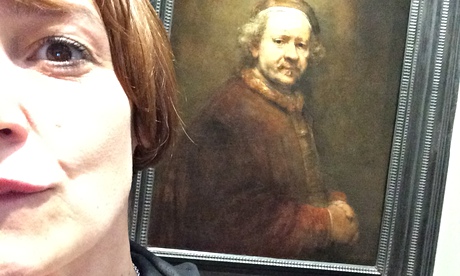
The National Gallery this week just threw up its hands and surrendered to the internet. "I had noticed custodians weren't leaping at people when they got their phones out," said art historian Barrie Garnham. "I just wondered whether maybe mobile phones don't emit the same kind of light." Not exactly – rather, it had become impossible to distinguish between people who were legitimately Googling for information, and people who were trying to take a photo.
So the gallery lifted the photography ban, except for some new displays with copyright issues. Art lovers were dismayed. The flash is a worry, of course. "I know that, for instance, there's a whole load of watercolours in the Wallace Collection that are behind a curtain," said Garnham, "not because they're filthy, but because even the ordinary gallery light will damage them in time."
But the more pressing anxiety is over the sheer sorry state of human nature. Nobody's just going to take a picture of Van Gogh's Sunflowers, are they? They're going to take a selfie, standing in front of it.
What's this going to do to art? What's it going to do to a generation? Even taking a picture of a painting itself changes the way you look at it – documenting rather than experiencing, thinking of posterity rather than the present. But then once you stick your big face in the foreground, the experience is different again, less like art and more like going to the seaside and putting your head above the body of a wrestler in a swimming costume.
Well, I have some good news for the purists: there was nobody taking selfies in the National Gallery on Thursday; nobody except me. It's possible that this memo hasn't got out yet, and not enough people know that it's allowed. But I think I can exclusively reveal the real reason: it is technically extremely difficult, but never quite difficult enough to distract you from the exquisite embarrassment.
People taking photos of art with their phones divide into two categories: thoughtful, discreet snappers of obscure tiny portraits of princesses, and everyone else taking pictures of Van Gogh. It seemed fitting to me that Van Gogh would be the go-to guy for an iPhone photo; he's the painter (I like to think) who would find the trend the most depressing.
Garnham disagreed. "It wouldn't be him in particular, it would be all of them. Because artists want you to look at their work, not use it as some backdrop, or exist at one remove from it." But artists wouldn't, through the ages, necessarily object to using technology. "In a way, it would be slightly hypocritical, because so many of them used optical devices to generate their paintings. Camera obscuras threw an image of the world on to a surface, and then you could trace round it.
"Later on, there were camera lucidas, even more convenient because they were compact and you could hide them," he said. "There's lots of evidence from the 17th century onwards, optical effects in Vermeer, Canaletto."
On this basis, I started with Vermeer. It's nothing he wouldn't have done to me, I thought, placing myself in front of A Young Woman Seated at a Virginal. I guess the problem was that we didn't look like we'd have got on in real life. So instead I took one of myself with Goya's Princess of Eboli, who looks more like my sort of person. I feel like we'd share a lot of interests (cheese). I was actually told off in the middle of doing this, by a person I think was speaking Hungarian. Not understanding him didn't make it any less mortifying. His meaning was pretty clear.
You can't take a selfie without going for the original selfie, Rembrandt's Self-Portrait at 63. The problem with the positioning of this painting is that Rembrandt comes out slightly better from the lighting, so I ended up looking older than 63. Also, this is one of the most venerated paintings in the gallery, even the nation. The disapproval in the room flooded towards me. I thought I heard someone hiss. It was like that bit at the end of Dangerous Liaisons when Madame de Thing is booed at the opera.
Reeling from shame, I chose a totally empty room for the next one, rather more obscure Philosophy, by the Italian Baroque painter Salvator Rosa. I spent some happy solitary minutes trying to frame it so that it looked like he was my boyfriend. Couldn't be done, but at least nobody saw me.
In short, there is nothing to fear, for either the art crowd or the custodians of the human spirit. The National Gallery will not be overrun by people taking selfies for the same reason it is not full of people in bikinis; we humans have a keen sense of humiliation, exposure, pride, vulnerability. That's what makes us worth painting in the first place.

